Exposing children to art museums at a young age will help them become more curious and, hopefully, develop a passion for art. The National Endowment for the Arts has an article that thoughtfully discusses the importance of taking children to museums. “Art museums provide memorable, immersive learning experiences, provoke imagination, introduce unknown worlds and subject matter, and offer unique environments for quality time with family.”
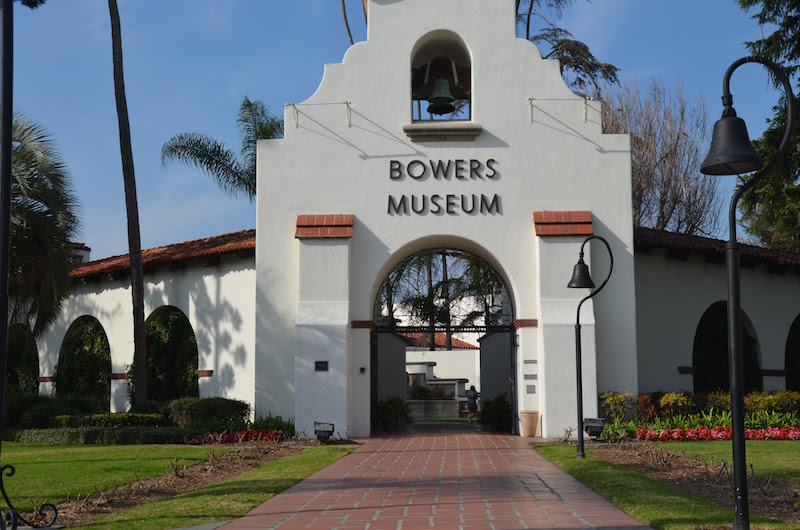
A visit to the Bowers Museum and Bowers’ Kidseum was the perfect mix of exposure to a classical museum combined with hands-on art for my five-year-old daughter. Popol Vuh: Watercolors of Diego Rivera stimulated critical thinking by asking what she observed during the visit.
According to the museum, Popol Vuh is collection of watercolors that center around the powerful creation story of an ancient civilization and also provides insight into Mexican muralist Diego Rivera’s passionate and creative vision of pre-Hispanic world. The show, which is exclusive to the Bowers, is on exhibition until May 29, 2016. It’s the first United States presentation of the 17 compelling watercolors on loan from the Museo Casa Diego Rivera in Rivera’s hometown of Guanajuato, Mexico.
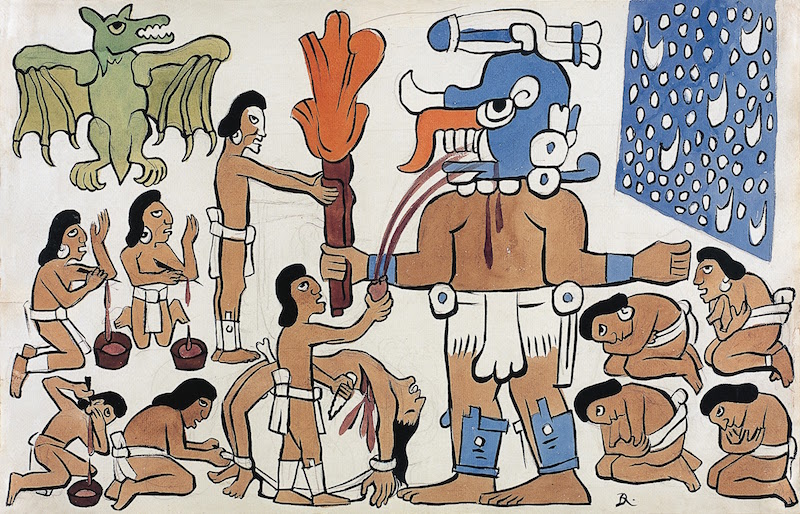
El sacrificio y el auto sacrificio humano ante el dios Tohil Human Sacrifice and Self- Sacrifce before the God Tohil (El Sacrificio y el Auto Sacrificio Humano ante el Dios Tohil) Diego Rivera,1931 Watercolor on paper
Having not been familiar with the Popol Vuh, I quickly learned that it’s considered the most important ancient text in existence from the Pre-Hispanic world and is considered sacred text. Popol Vuh is an epic tale recording the origins, traditions, legends and history of the Quiché-Maya people from the dawn of creation until contact with the Spanish. The survival of the Popol Vuh is extraordinary, especially when considering that nearly Spanish conquerors or missionaries destroyed every ancient Mesoamerican document. For some unknown reason the Popol Vuh was spared through translation into Spanish text by an 18th century priest.
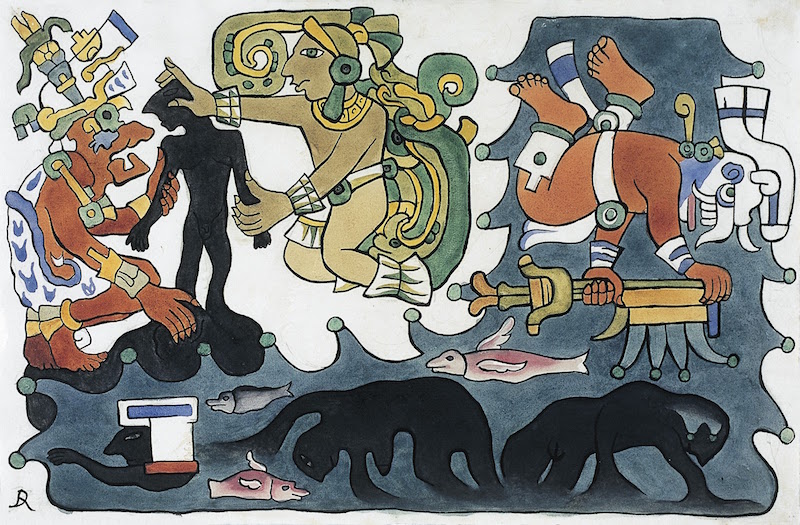
La creación del hombre
The Creation of Man (La Creación del Hombre)
Diego Rivera,1931
Watercolor on paper
Rivera became acquainted with writer John Weatherwax in 1931. Weatherwax, who is said to have read the Popol Vuh aloud to Rivera, asked Rivera to illustrate select passages of the manuscript as he read. Rivera completed 24 watercolors in all, selecting parts of the text most inclined to evoke imagery. The result was a set of beautifully colored, highly stylized paintings with their root firmly in the Classic Mayan tradition.
While we did tour through the entire museum, the Diego Rivera show was definitely the highlight. I’ll admit that my daughter was happy to look at the paintings, but particularly liked the film that told the story of Popol Vuh through colorful imagery (in Spanish with English subtitles).
A hop, skip and a jump to Kidseum
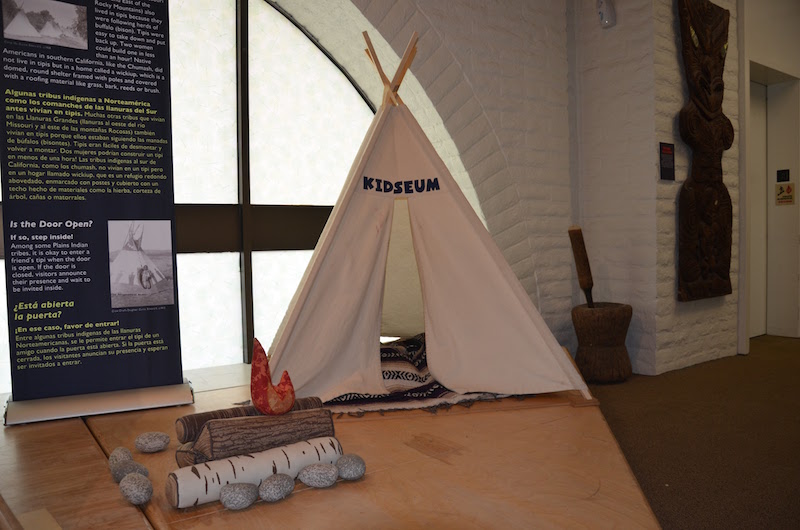
After using our quiet voices at the Bowers, we walked a block for some interactive learning at newly renovated Kidseum. The children’s museum is now high-tech and boasts a new mission, “Igniting Imagination Through Exploration,” stressing the excitement of art, archaeology and different world cultures.
We definitely ignited our imaginations with the Green Screen Time Machine. Kids are invited to dress up and travel through time to five historical sites: Machu Picchu, Stonehenge, Great Wall of China, Coliseum, and Giza Pyramids using green screen technology. It’s clear that everyone wants his or her 15 minutes of fame. The renovated museum also has an indoor and outdoor Archaeology Lab. Although the outdoor area was closed when we went, the Lab’s smart drawing table was a highlight. In the Glow Cave, kids were excited to use neon paints that glowed under the Cave’s black lights. Your own kids might be asking for a Glow Cave when you get back home.
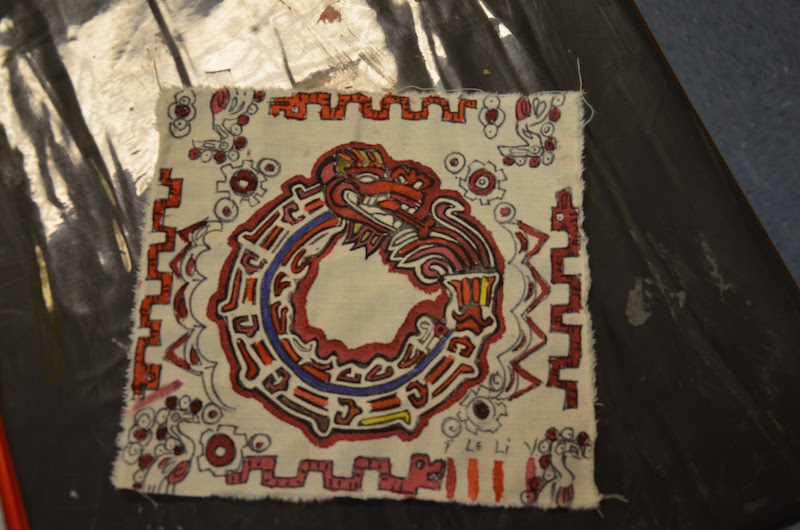
Unlike most children’s museums, Kidseum was not crowded when we arrived, making it easy for us to participate in an art project based on The Red that Colored the World exhibit we saw at the Bowers. We painted with cochineal dye on a muslin fabric that had been printed with a Pre-Colombian design. We had just learned that this vibrant red dye was extracted from the cochineal insect! Dye from bugs is much more exciting than regular paint.
Kidseum has a free play area to explore at your child’s own pace whether that’s playing music on the world drums, setting up pretend fires next to a teepee or making breakfast in the pop-up mini camper. There are also two story times each day and our storyteller was very animated and kept all of the children’s undivided attention. Story time was a good end to the almost two hours spent at the museum.
Caveat: The museum is best for the 7 and under crowd. I was surprised by how long my daughter wanted to be there due to the small size of it, but the programs were engaging and not having to wait in any lines was a bonus.
Kidseum Scheduled Daily Adventures:
- Face painting all day
- Drop in Art Studio all day
- Live Storytelling in the Story Room (2x a day)
- Glow Cave Paintings
- Archaeology Lab
More about the Bowers Museum
The Bowers Museum has earned an international reputation through its world-class exhibitions, including Warriors, Tombs and Temples: China’s Enduring Legacy, Terra Cotta Warriors: Guardians of China’s First Emperor, Secrets of the Silk Road, and Mummies – Death and the Afterlife: Treasures from the British Museum, as well as its own extensive art collections from throughout the Americas and the South Pacific. Additionally, the Bowers’ Kidseum, located one block south of the main museum, offers a high-tech and interactive focus on its new mission of “Igniting Imagination through Exploration” spotlighting the excitement of art and archaeology.
Bowers Museum 2002 North Main Street // Santa Ana CA 92706 // 714.567.3600
Open: Tuesday through Sunday, 10am to 4pm.
Kidseum is located one block south of the Bowers Museum at 1802 N Main Street.
Open: Saturday and Sunday, 10am to 4pm
Written by Heather Koopman
IMAGE CREDIT:
“REPRODUCCIÓN AUTORIZADA POR EL INSTITUTO NACIONAL DE BELLAS ARTES Y LITERATURA 2015”
D.R. © 2015 Banco de México, Fiduciario en el Fideicomiso relativo a los
Museos Diego Rivera y Frida Kahlo. Av. 5 de Mayo No. 2, Col. Centro, Del.
Cuauhtémoc 06059, México, D.F.

